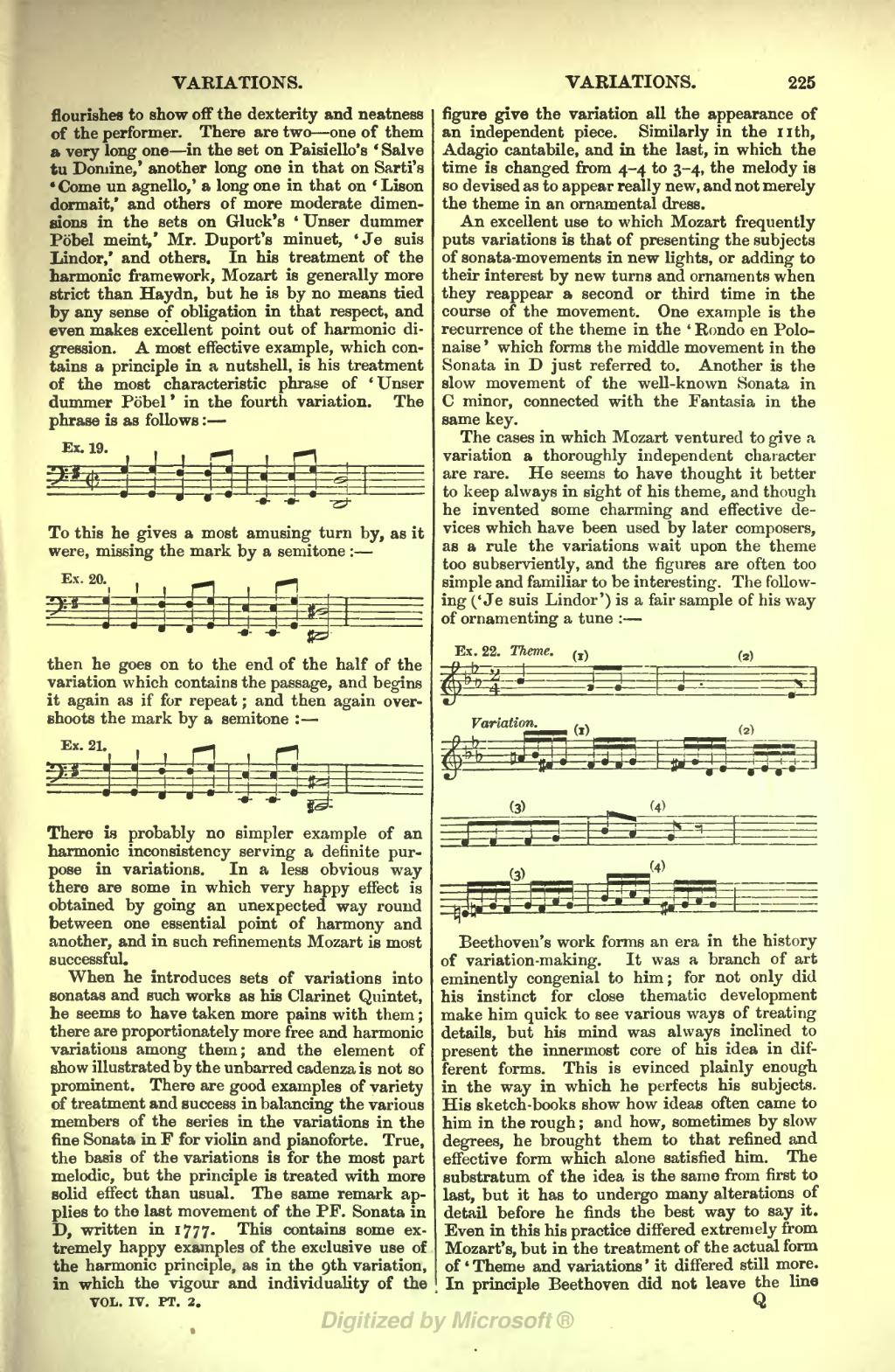flourishes to show off the dexterity and neatness of the performer. There are two—one of them a very long one—in the set on Paisiello's 'Salve tu Domine,' another long one in that on Sarti's 'Come un agnello,' a long one in that on 'Lison donnait,' and others of more moderate dimensions in the sets on Gluck's ' Unser dummer Pöbel meint,' Mr. Duport's minuet, 'Je suis Lindor,' and others. In his treatment of the harmonic framework, Mozart is generally more strict than Haydn, but he is by no means tied by any sense of obligation in that respect, and even makes excellent point out of harmonic digression. A most effective example, which contains a principle in a nutshell, is his treatment of the most characteristic phrase of 'Unser dummer Pöbel' in the fourth variation. The phrase is as follows:—

To this he gives a most amusing turn by, as it were, missing the mark by a semitone:—

then he goes on to the end of the half of the variation which contains the passage, and begins it again as if for repeat; and then again overshoots the mark by a semitone:—

There is probably no simpler example of an harmonic inconsistency serving a definite purpose in variations. In a less obvious way there are some in which very happy effect is obtained by going an unexpected way round between one essential point of harmony and another, and in such refinements Mozart is most successful.
When he introduces sets of variations into sonatas and such works as his Clarinet Quintet, he seems to have taken more pains with them; there are proportionately more free and harmonic variations among them; and the element of show illustrated by the unbarred cadenza is not so prominent. There are good examples of variety of treatment and success in balancing the various members of the series in the variations in the fine Sonata in F for violin and pianoforte. True, the basis of the variations is for the most part melodic, but the principle is treated with more solid effect than usual. The same remark applies to the last movement of the PF. Sonata in, written in 1777. This contains some extremely happy examples of the exclusive use of the harmonic principle, as in the 9th variation, in which the vigour and individuality of the figure give the variation all the appearance of an independent piece. Similarly in the nth, Adagio cantabile, and in the last, in which the time is changed from 4-4 to 3-4, the melody is new, and not merely the theme in an ornamental dress.
An excellent use to which Mozart frequently puts variations is that of presenting the subjects of sonata-movements in new lights, or adding to their interest by new turns and ornaments when they reappear a second or third time in the course of the movement. One example is the recurrence of the theme in the 'Rondo en Polonaise' which forms the middle movement in the Sonata in D just referred to. Another is the slow movement of the well-known Sonata in C minor, connected with the Fantasia in the same key.
The cases in which Mozart ventured to give a variation a thoroughly independent character are rare. He seems to have thought it better to keep always in sight of his theme, and though he invented some charming and effective devices which have been used by later composers, as a rule the variations wait upon the theme too subserviently, and the figures are often too simple and familiar to be interesting. The following ('Je suis Lindor') is a fair sample of his way of ornamenting a tune:—

Beethoven's work forms an era in the history of variation-making. It was a branch of art eminently congenial to him; for not only did his instinct for close thematic development make him quick to see various ways of treating details, but his mind was always inclined to present the innermost core of his idea in different forms. This is evinced plainly enough in the way in which he perfects his subjects. His sketch-books show how ideas often came to him in the rough; and how, sometimes by slow degrees, he brought them to that refined and effective form which alone satisfied him. The substratum of the idea is the same from first to last, but it has to undergo many alterations of detail before he finds the best way to say it. Even in this his practice differed extremely from Mozart's, but in the treatment of the actual form of 'Theme and variations' it differed still more. In principle Beethoven did not leave the line
